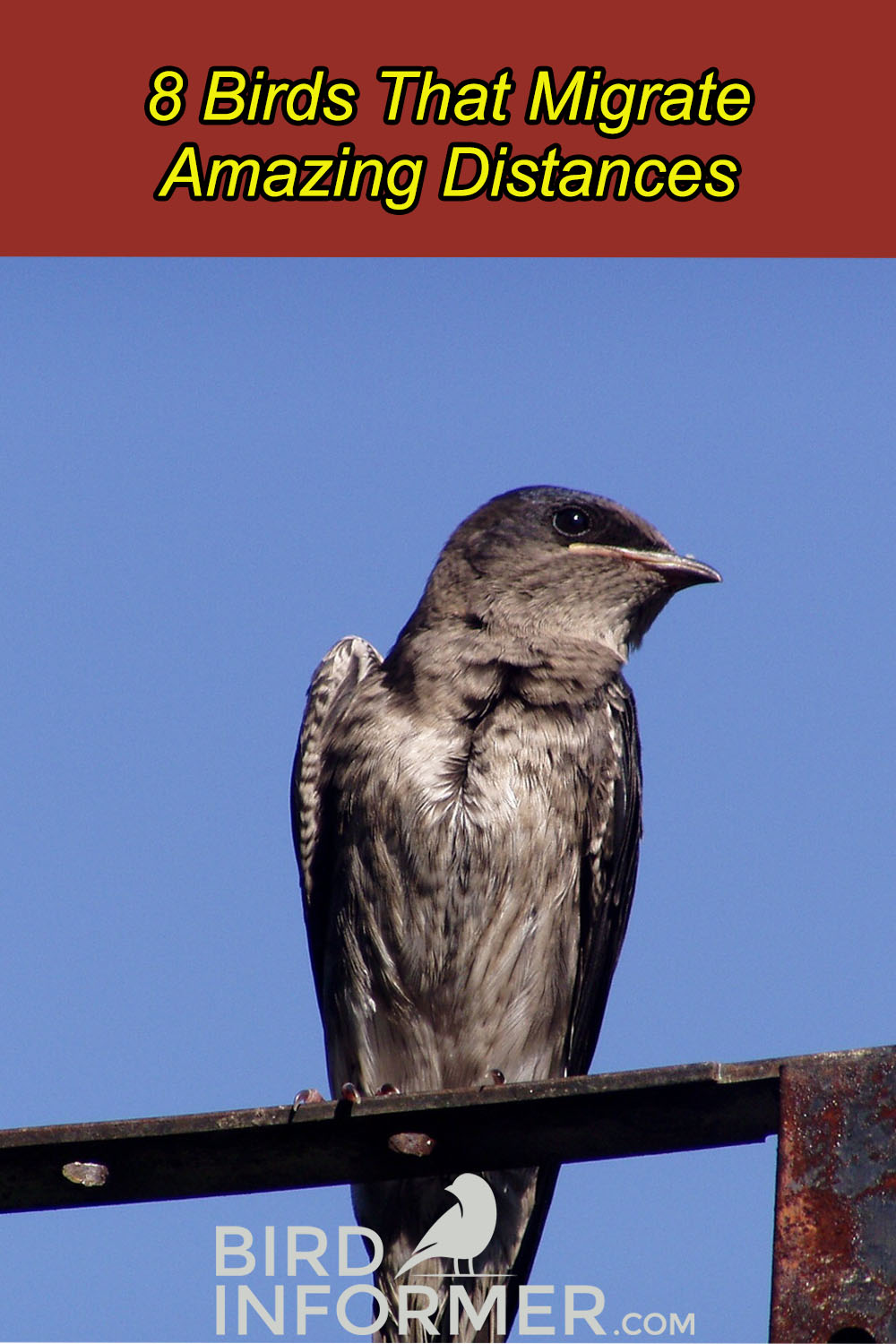Contents [show]
As winter approaches, we notice how some birds in our area start leaving and arriving. It’s a yearly cycle, and it has always been fascinating to watch.
However, have you ever wondered where the birds go?
Well, some may stay within the area, others may travel a little bit far, but there are also those who travel very long distances. This includes these eight migratory bird species:
- Arctic Tern
- Red Knot
- Peregrine Falcon
- Ruddy Turnstone
- Blackpoll Warbler
- Purple Martin
- Scarlet Tanager
- Canada Goose
In this article, we’re going to dive more into how far these birds travel, where they travel, and what their migration pattern looks like.
Migratory Bird Chart
| Migratory Bird Species | Overall Distance | Mile Distance Between Stopover Sites | Wingspan Length |
| Arctic Tern | 25,000 miles | 242-416 | 25- 30 inches |
| Red Knot | 18,600 miles | 4,971 – 5,592 | 20-22 inches |
| Peregrine Falcon | 15,500 miles | 8078 | 2.4 – 3.9 ft. |
| Ruddy Turnstone | 13,000 miles | 621 | 19.7 – 22.4 inches |
| Blackpoll Warbler | 12,400 miles | 2,100 | 7.9 – 9.8 inches |
| Purple Martin | 6,200 to 13,700 miles | 174- 358 miles per day on average. However, during the first part of fall migration, they fly about 500 miles. | 14.9 inches |
| Scarlet Tanager | 5,400 miles | n/a | 9.8 – 11.4 inches |
| Canada Goose | 2,000 to 3,000 miles | 250 – 227 | 4.2 – 6.1 ft. |
So, if you’re interested to know more about these migratory bird species, keep reading below.
Arctic Tern
Yearly Migration Distance: 25,000 miles
Arctic Terns hold the record for having the longest migration, not only in the bird kingdom but for the whole animal kingdom. These birds cover around 25,000 miles every year from their breeding ground in the Arctic, going to Antarctica and back.
These are small and slender birds, reaching only lengths of 11.0-15.3 inches, a wingspan of 25.6-29.5 inches, and weighing only 3.2-3.4 ounces. You’ll also notice how they have pointed wingtips and a forked tail.
In the sky, you’ll see these birds as a flock of beautiful black and white birds, flying at speeds of 35 to 40 kph.
Where Can You Find Arctic Terns
Arctic Terns are breeds in Alaska and the Northern parts of Canada. However, they don’t stay very long as these birds move around a lot. They are also not seen anywhere south of their breeding grounds.
These birds can be found anywhere near the ocean, rocky coasts, small islands, and anywhere else with very few trees. They find food in the water, hovering around 30-40 feet above the sea, before diving in to catch small fish to eat.
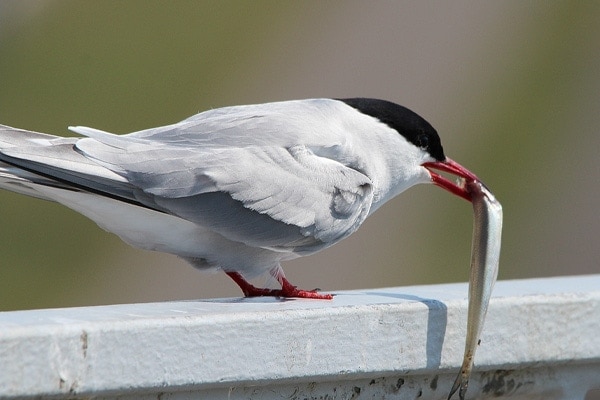
Arctic Tern Migration Pattern
Arctic Terns move constantly, making a circle around the Earth.
Their movement starts in summer from their coastal breeding grounds going west to the southernmost point of South America. The birds then migrate across the North Atlantic Ocean, going to Europe and northern Africa.
The birds will then head farther down south, going to the southern part of Australia, New Zealand, and Antarctica. Crossing the Pacific, they reach back to their breeding grounds in the Arctic Circle and northern parts of America.
Why Go Through All This Trouble?
If you look at the Arctic Tern’s migration pattern, it’s truly a long journey for these little birds. So, why do they go through all this trouble going circle around the world?
It turns out that the Arctic Terns migrate by following the summer sun. This way, they don’t experience any winter or significant temperature changes. It wouldn’t also be harder for them to find food in summer, compared to when they have to experience winter while in the Arctic.
It’s a survival tactic for these birds. But the fact that they are lightweight and mostly glide in the air makes long-distance travel easier than other birds. They don’t use a lot of energy compared to birds who need to flap their wings continuously.
It’s also found that Arctic Terns can fly a distance of 1,000 miles without stopping.
Red Knot
Yearly Migration Distance: 18,600 miles
The Red Knot is a shorebird found in almost every continent except Antarctica. They are found in the most northern parts of North America and winters in southern South America, flying a distance of up to 9,300 miles twice a year.
Despite having “red” in their name, Red Knots have orange-colored feathers on their underparts. On the other hand, their upper parts form a mixed pattern of gold, brown, rusty, and black.
These birds grow at only 9.1-10.6 inches in length, have a wingspan of 22.4-23.6 inches, and weigh 4.4-7.2 ounces. The birds also feature long dark or greenish legs and long dark bills.
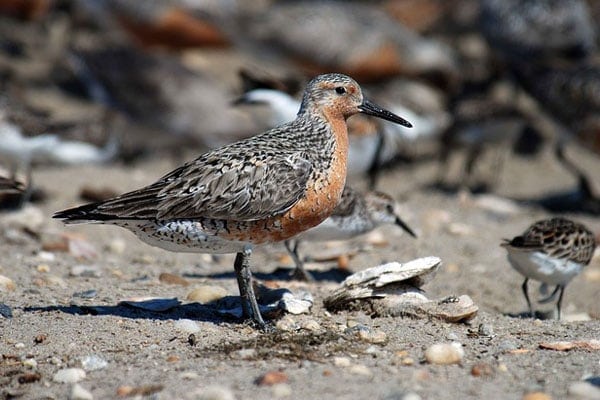
Where Can You Find Red Knot
In North America, Red Knots are only found in the northernmost parts, near the Arctic Ocean. They are no longer found in many places, except in coastal areas of the United States and Mexico, where they stop over during migration.
As shorebirds, Red Knots are common in open sandy beaches, coastal mudflats, and tidal zones during winter. However, during the breeding season, they are often found in dry tundra slopes in the Arctic but are always near bodies of water like ponds and streams.
Red Knot Migration Pattern
Red Knots are long-distance migratory birds traveling a distance of more than 9,300 miles twice a year.
After breeding season in the Arctic, the birds leave for their southern wintering grounds. They stop over the coastal areas in the US before traveling down south up to the tip of South America.
They repeat the trip after winter, leaving their wintering grounds and flying back to the Arctic. They usually arrive before the snow completely melts, giving them enough time to prepare to build some nests for their eggs.
Sadly, the Red Knot’s population is continuously declining as the years pass, and it seems that sea-level rise in their stop-over locations is a factor.
Peregrine Falcon
Yearly Migration Distance: 15,500 miles
The Peregrine Falcon is known as a powerful and fast-flying bird. Named as the “wanderer”, this bird travels a lot outside the nesting season, traveling a distance of up to 15,500 miles every year.
These are medium-sized birds measuring 14.2-19.3 inches in length, a wingspan of 39.4-43.3 inches, and weighing 18.7-56.4 ounces. These birds are the largest falcon in almost every continent and feature long, pointed wings and long tails.
Flying in the air, you’ll notice how these birds are heavily streaked in their underparts while having a blue-gray upper part. They’re fast flyers, reaching speeds of up to 68 mph when flying horizontally. But as they dive, they can reach speeds of up to 200 mph.
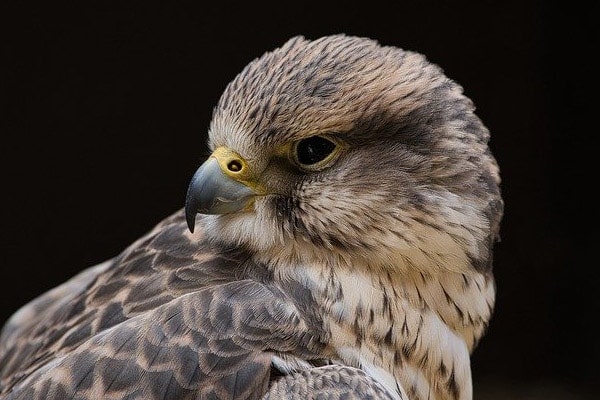
Where Can You Find Peregrine Falcons
Peregrine Falcons are widespread birds. They are found in almost every continent except Antarctica.
In North America, you’ll find them in Alaska, northern parts of Canada, some parts of the United States, and Mexico. They are usually in open landscapes with cliffs and are found nesting in areas up to 12,000 feet above the ground.
They can also be found near bodies of water like along the rivers and coastlines. Some Peregrine Falcons were even recorded to be found in the cities.
Peregrine Falcon Migration Pattern
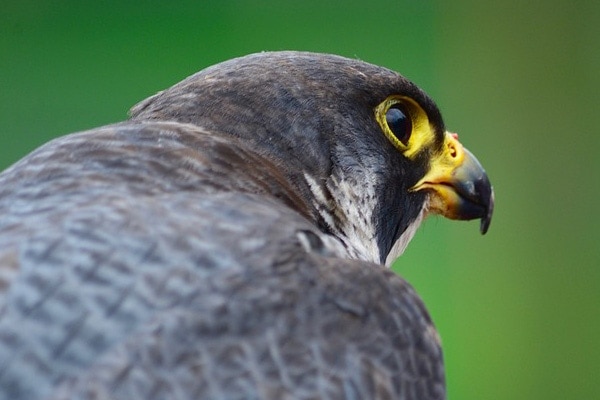
Peregrine Falcons migrate long distances. It’s also considered as one of the North American birds that travel the longest.
These birds breed in northern parts of Alaska and Canada and some parts of Montana and Wyoming in the US. They winter mostly in some parts of the US, including coastal areas in Louisiana, Florida, Georgia, South Carolina, and North Carolina.
There are also resident Peregrine Falcons found in the coastal areas of British Columbia, Washington, Oregon, California, and all parts of Mexico.
These birds travel a total of 15,500 miles per year and regularly cross the Gulf of Mexico and the Caribbean Sea. Migration would also usually take them in South America, particularly in Central Argentina and Chile.
Ruddy Turnstone
Yearly Migration Distance: 13,000 miles
The Ruddy Turnstone is a shorebird that is almost compared to a Calico cat due to its color pattern. You’ll observe that their heads have unique black-and-white markings down to their throat, and they have a black, white, and orange pattern on their back.
These birds are almost the same size as a robin and grow at a length of 8.3-6.3 inches. Their wingspan is at 19.7-22.4 inches, and they weigh around 3.0-6.7 ounces.
The name turnstone came from their behavior of turning over stones along shores in search of food. But other than that, the birds also feed by pecking into cracks.
With a speed of 40 mph, Ruddy Turnstones fly more than 6,500 miles twice a year. There’s even a record that shows how some birds have flown 4,720 miles non-stop.
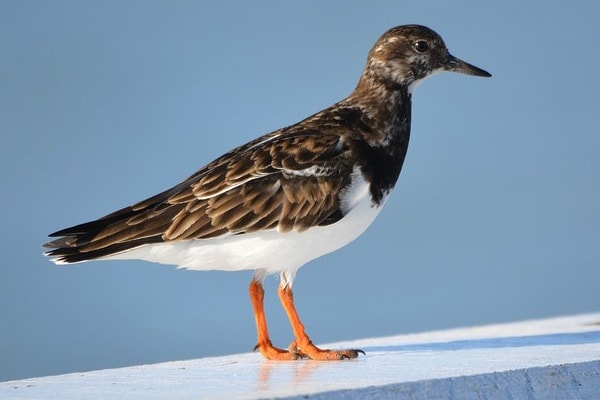
Where Can You Find Ruddy Turnstone
Ruddy Turnstones are shorebirds, which means they are found mainly in coastal areas.
The birds breed in the northernmost part of North America, mainly in the Arctic. They also breed in coastal areas of Alaska and Greenland. In winter, you’ll find them along the coasts of the United States and Mexico.
These birds are found near bodies of water. They breed in Arctic tundras and rocky coasts. Other areas you’ll find them are near marshes and along streams and ponds.
They also make their stopovers and spend their winter along coastal areas, sandy beaches, and shorelines.
Ruddy Turnstone Migration Pattern
Ruddy Turnstones are long-distance migratory birds that travel more than 6,500 miles every year. They migrate to various locations, sometimes reaching South Africa and Australia for winter.
The typical pattern of the birds is from their breeding grounds they’ll stop by the coasts of the United States, then fly down to South America, then to southern Africa and Australia. Sometimes, the route depends on where the birds come from.
For example, if the birds come from Alaska, they would usually winter in coastal areas of North America, Australia, and New Zealand. If the birds come from Canada, they would winter on the coasts of the United States and fly down south to South America. Some birds even winter in Europe.
It’s also found that these birds often travel with other shorebird species like the Red Knot and Dunlin. You’ll probably even find them in their wintering areas along with the Black Turnstone.
Blackpoll Warbler
Yearly Migration Distance: 12,400 miles
The Blackpoll Warbler is a small-sized bird growing at a length of 5.5 inches, a wingspan of 8.3-9.1 inches, and weighing only .4-0.5 oz. But despite their small size, they have incredible stamina, which allows them to fly up 2,100 miles without stopping.
These birds feature a black cap, white cheeks, and black-and-white colored bodies during summer. But when winter comes, they appear yellow-green in their upper parts with dark streaks in the underparts.
Although very impressive birds, the Blackpoll Warbler’s population has significantly declined for years. It’s recorded that about half of their population is gone in just 40 years. And it is found that their long-distance migrations may be a factor in this.
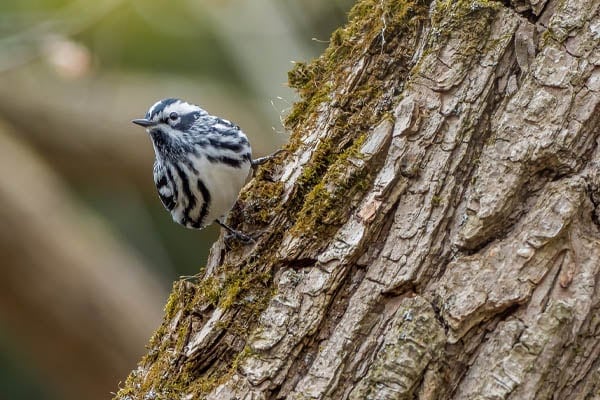
Where Can You Find Blackpoll Warblers
Blackpoll Warblers are mainly found in Alaska and northern parts of Canada. You can also find them in the Eastern parts of the US during their migration as they prepare to fly over the Atlantic Ocean to their wintering grounds in South America.
In South America, Blackpoll Warblers are found in Valenzuela, northern parts of Colombia, and Brazil.
These birds are mainly found in forests, breeding in conifers, spruce, and thickets. They then winter in any wooded areas, which will include parks and gardens.
Blackpoll Warblers Migration Pattern
Blackpoll Warblers breed in North America, particularly in Alaska and northern parts of Canada. Once migration starts, the birds travel through most of the eastern part of the United States, eating as much food as possible to prepare them for an oceanic cross going to South America.
The birds would stop in some coastal areas in the eastern United States before crossing the Atlantic Ocean without stopping. It would usually take them 72 hours before they reach Valenzuela, and then they move to their wintering grounds in Colombia and Brazil.
As they go back to their breeding grounds, they would need to make the same stops in Valenzuela before flying across the Atlantic Ocean again. The whole round trip would equal 12,400 miles.
It’s an incredible journey for these small birds.
Purple Martin
Yearly Migration Distance: 6,200 to 13,700 miles
The Purple Martin is a songbird that a lot of backyard bird feeders indeed love to see. They are one of the largest swallows and are recorded to migrate a distance of 6,200 to 13,700 miles every year.
Despite being named “purple”, the male Purple Martin birds have a dark blue to purple color. They also feature a pair of brown-black wings and tails. On the other hand, females appear to be duller, with several visible gray colors shown on their head and chest.
Purple Martins grow about 7.5-7.9 inches in length, has a wingspan of 15.3-16.1 inches, and weighs around 1.6-2.1 ounces. They can fly at speeds of more than 40 miles per hour and usually feeds while high up in the air.
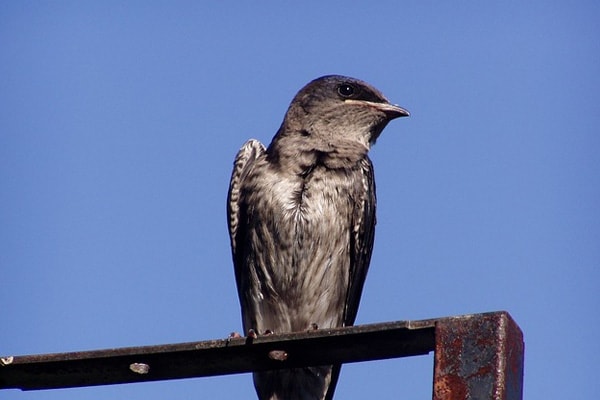
Where Can You Find Purple Martins
Purple Martins are found mainly in the eastern parts of the United States, from North Dakota down to Texas and going eastward to Florida up to Delaware and New Jersey. They are also found in some coastal areas of Oregon and California and some parts of Arizona, Colorado, and even some parts of Mexico.
These birds can be found in any open area searching for food in public places like cities, towns, and parks. They are also found in dry and wet areas like the open fields, along the streams, ponds, and wet meadows.
They usually breed along the edges of forests and near rivers. But there are also times when they visit backyard bird feeders and find shelter in nest boxes.
Purple Martin Migration Pattern
Purple Martins are long-distance migratory birds traveling an average of 5,000 miles every year. They breed across the eastern United States and sometimes form large flocks in the coastal areas of Texas to Florida.
They fly across the Gulf of Mexico to reach their wintering grounds in South America, mainly in Colombia, Venezuela, Brazil, Bolivia, Paraguay, and Argentina.
After spending winter, they take the same route to reach the coast of Florida and into their respective breeding grounds. They usually fly only during the day and would feed on mosquitoes while flying.
Purple Martins are also considered to be the earliest to arrive among migratory birds as they arrive in Florida in the middle of January.
Scarlet Tanager
Yearly Migration Distance: 5,400 miles
The Scarlet Tanager is probably one of the most beautiful birds you can attract in your yard. But aside from being beautiful birds, Scarlet Tanagers are also great flyers, flying over 2,700 miles twice a year to reach their wintering grounds and back.
As their name implies, the male bird feathers shine a bright scarlet red during summer, and their wings and tails are black. Females, on the other hand, are greenish-yellow in color with darker olive-green wings and tails.
Scarlet Tanagers aren’t big birds. They only grow at a length of 6.3-6.7 inches, a wingspan of 9.8-11.4 inches, and only weigh 0.8-1.3 ounces.
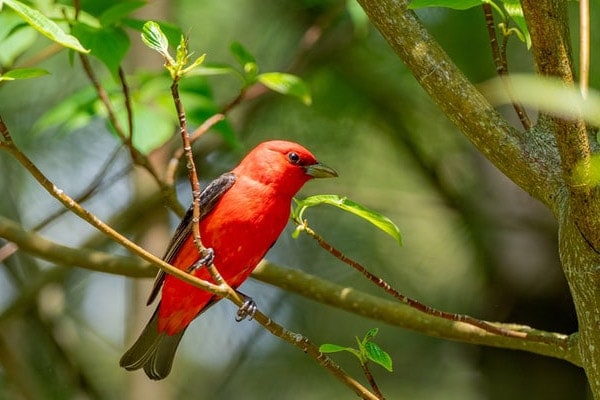
Where Can You Find Scarlet Tanagers
Scarlet Tanagers breed in eastern North America and winter down to South America.
Their breeding range in Canada starts from lower Manitoba, extending east to Nova Scotia. In the US, the birds breed mainly in the upper eastern parts starting from Minnesota down to Arkansas and going east to Maine.
The birds’ winter range, on the other hand, starts from upper Panama, going south to Bolivia.
These birds are often seen in deciduous and mixed forests. But there are cases where they also find shelter in parks and gardens with many oak trees, pine-oak trees, and beech trees.
Birds are also recorded to be found in open areas like grass fields and shrubby vegetations.
Scarlet Tanager Migration Pattern
Scarlet Tanagers are long-distance migrants that yearly fly 2,700 miles across the Gulf of Mexico from their breeding grounds in North America to their wintering grounds in the South. The birds leave at night and start moving south mid-summer, and the peak of migration begins in early October.
They follow the same route when they go back to their breeding grounds and usually arrive around late April.
Canada Goose
Yearly Migration Distance: 2,000 to 3,000 miles
The Canada Goose is probably one of the most popular birds in North America and is found in most of the United States and Canada.
This is the largest bird in this list as the bird grows at 29.9-43.3 inches in length. They also have a wingspan of 50.0-66.9 inches and weigh around 105.8-317.5 ounces. However, their size doesn’t stop the geese from flying more than 2,000-3,000 miles per year.
With a speed of 40-70 mph, Canada Geese can cover a distance of 1,500 miles in 24 hours. You’ll often see them in V-formations in the air, and flocks are known to stay together all year round.
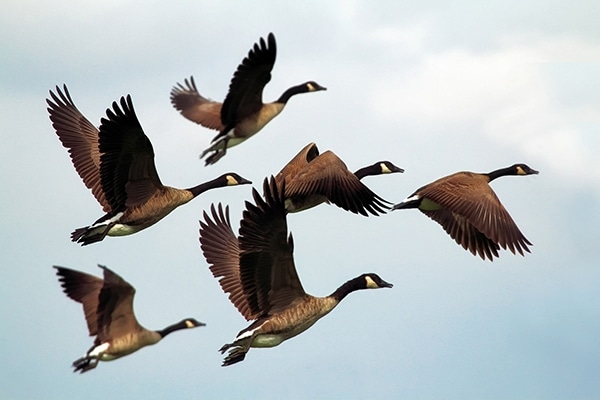
Where Can You Find Canada Geese
Canada Geese breed in Alaska, Canada, and the US. Birds in the northern parts of the US are mainly resident birds, while the birds in the southern parts of the US only stay through the winter.
These birds are adaptable to many habitats may it be near water areas or grassy fields. The birds love open areas with a lot of grass available to eat. That’s why you can see them in many urban and suburban where you can find many grassy lawns such as parks, golf courses, and even airports.
Canada Goose Migration Pattern
Canada Geese breed across all of North America but never reach the northernmost or southernmost parts of the continent.
These birds fly down south from their northern breeding grounds during the fall. They often reach the southern parts of the United States down to Mexico. When Spring starts, the birds fly back to their northern breeding grounds.
The birds always form a “V” in the sky, and if you’ve seen a group of Canada Geese migrating, you have probably noticed how noisy they are. This is because honking is the best way for Canada Geese to communicate during their flights. This helps them change positions to reduce tiredness for each bird.
What is the V-formation?
The V-formation also called an echelon formation, is very common with geese, ducks, and other large-migratory birds. The purpose of this is to save the birds’ energy, so they don’t get really tired.
How does it work?
The birds will have one leader in front, and the rest of the birds form a V-shaped behind. The bird at the front is the one who will usually spend the most energy to fly while the rest behind diminishes the energy they use, thanks to the wind vortex created by birds in front.
Once the leader gets tired, she’ll move back to the end of the tail and will be replaced by someone else.
FAQs
Why do birds migrate?
Birds migrate due to two reasons: food and nesting.
After the breeding season, birds usually spend winter in other areas where they know there’s more food. But once winter is over, they go back to their breeding grounds, where it’s more suitable for them to build nests.
What are the different types of migration?
There are four different types of migratory birds:
- Permanent or resident birds: These birds don’t migrate as there is an adequate food supply in their area.
- Short-distance migratory birds: These birds travel short distances away from their breeding areas. Mostly, they just change elevations or move to a different state.
- Medium-distance migratory birds: These birds travel further, passing several states to their wintering grounds.
- Long-distance migratory birds: These birds travel the longest, sometimes reaching months before they get to their wintering grounds. A good example is when a bird travels from the US to their wintering grounds in South America.
What do birds eat during migration?
Many birds fatten up before migration, so they have enough energy on their journey. They need to eat foods high in protein and low in fat. Planting some high-protein seed-bearing trees and shrubs would help migratory birds on their way. You can also hang feeders with suet as this is an excellent source of energy for migratory birds.
How do birds survive long migrations?
Migratory birds, especially long-distance migratory birds, have developed unique adaptations to survive their journeys. A great example of this is the Geese which practice V-shape formations in the sky – a formation that requires excellent teamwork so all of them can survive.
How do birds navigate and not get lost?
While humans would require a map and a compass to navigate, birds rely on their senses. Researchers have found four ways they can do this:
- Some birds have a compound called magnetite above their nostrils which serves as a GPS unit for birds. This helps them use the Earth’s magnetic field to tell them where they are.
- Some birds are also found to have specialized cells in their eyes so they can see magnetic fields.
- Some birds rely on their eyesight and use landscapes to remember where their home is.
- Some birds look at the sun and star’s position to stay in the right direction.
How does migration affect bird populations?
While it’s impressive to know how far birds can reach during migrations, it still poses a risk to their populations. Many birds die on the way due to weather conditions, flashes, building collisions, and many more.
However, it’s still a risk they’re willing to take if that means they could eat more food and would enjoy warmer weather. It’s also found that the number of birds they hatch during the breeding season tends to compensate for the numbers they’ve lost.
When can you see long-distance flyers?
Long-distance flyers are hard to see compared to other birds. This is because they usually just stop by for a little while and then start flying off again.
If it’s the migrating season, you would want to fill up your backyards with high-energy foods. This will help attract migrating birds, and if your consistent, they might make your backyard one of their stopover areas during their flight.
Final Thoughts on Bird Species That Migrate Long Distances
Birds are amazing little creatures, and they’d absolutely do anything to survive, even if that includes traveling great distances in search of food and a suitable home. The birds on the list above are great examples of this.
However, not all these birds became long-distance migrants immediately. Each of them did so because it’s needed.
As the years pass, the environment changes, too. Birds’ habitats are affected, weather changes became harsher, and the birds need to adapt. And traveling is one of the best ways they see as a solution to their problem.
There’s no doubt how migration can impact the birds’ population, causing a steep decline in some bird species like the Red Knots and Blackpoll Warblers. That’s why it’s probably best if we all try to reduce the effects of climate changes and preserve their habitats, so they have shelter every time they migrate.

